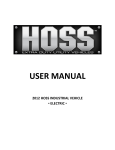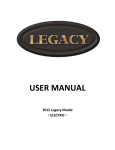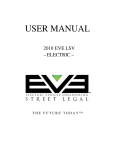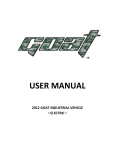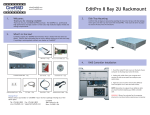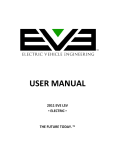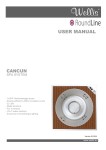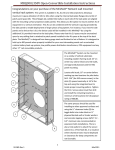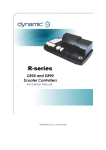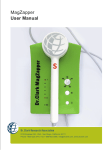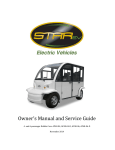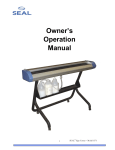Download USER MANUAL
Transcript
USER MANUAL 2012 EVE LSV ▪ ELECTRIC ▪ THE FUTURE TODAY. ™ FORWARD Thank you for purchasing the Eve model Evergreen Electric Vehicles, LLC. Your Eve Model has excellent performance characteristics, fashionable design features and internal systems to provide a comfortable and safe ride. Your ongoing satisfaction is important to us, therefore, we strongly recommend you read this user manual completely and discuss any questions you have regarding safety and operation with your local Authorized EVE Dealer. Please pass this user manual onto the next owner so they might too become familiar with the EVE model. EEV-EVE-7.27.11 PRECAUTIONS WARNING!!! The EVE model electric car complies with NHTSA – Title 49 CFR 571.500, Low Speed Vehicle regulations. Street legal electric vehicles require license plates and registration before use on public streets. Please comply with all state and local laws and requirements. WARNING!!! The RED warning text shown here appears throughout the user manual. Please pay special attention to these safety warnings in order to prevent injury to your property, driver, occupants and/or persons around you during operation. WARNING!!! Operators of the EVE Electric Vehicle must be over the age of 16 years and have a valid driver’s license to operate this Street Legal Vehicle. WARNING!!! Evergreen does not provide any EVE model with a rear facing seat kit nor does Evergreen condone the use of a rear facing seat on any EVE Low Speed Vehicle. Contents of this manual are subject to change without notice. Copyright © 2012 Evergreen Electric Vehicles, LLC 743 Horizon Ct. Suite #333 Grand Junction, CO 81506 970.257.0346 EEV-EVE-7.27.11 CONTENTS OPERATING SYSTEM ------------------------------------------------------------------------------------------------ 1 PRE-OPERATION INSPECTION ITEMS --------------------------------------------------------------------------- 1 FUNCTIONS OF OPERATING SYSTEM --------------------------------------------------------------------------- 2–5 OPERATING PROCEDURES ---------------------------------------------------------------------------------------- 5 RULES FOR SAFE OPERATION ------------------------------------------------------------------------------------ 6 SAFETY FEATURES -------------------------------------------------------------------------------------------------- 7 MAINTENANCE OF BATTERIES ----------------------------------------------------------------------------------- 8 SCHEDULED MAINTENANCE PROCEDURES ------------------------------------------------------------------- 9 – 10 SCHEDULED OILING/LUBRICATION PROCEDURES ---------------------------------------------------------- 11 STORING THE VEHICLE --------------------------------------------------------------------------------------------- 12 TOWING OR TRAILER TRANSPORT ------------------------------------------------------------------------------ 12 MAINTENANCE OF MOTOR --------------------------------------------------------------------------------------- 13 MAINTENANCE OF SPEED CONTROLLER ----------------------------------------------------------------------- 13 TROUBLE SHOOTING GUIDE -------------------------------------------------------------------------------------- 14 WARRANTY ----------------------------------------------------------------------------------------------------------- 15 – 16 NOTES ------------------------------------------------------------------------------------------------------------------ 17 – 18 EEV-EVE-7.27.11 OPERATING SYSTEM Fig. 1 PRE OPERATION INSPECTION ITEMS Your Electric Car received an overall inspection at the manufacturing facility and a final inspection by your local dealer prior to delivery. However, it is important to acquaint yourself with the controls and operation of the vehicle. 1. Perform your own visual inspection to ensure that all parts are secure and appear to be installed properly. Any item that may interfere with clear view, ability to start and stop the vehicle, or use the steering wheel properly to control the direction of travel should be discussed with your local dealer immediately. 2. Check all printed warning labels located on the vehicle. 3. Check under the seat bottom in the battery area. All wire connections on the battery terminals should be tight, secure, and corrosion free. Your new electric car will be delivered with a full charge, please consult Page 6: Maintenance of Batteries and Use of Charger. 4. Test drive the car for proper braking, acceleration and steering control. When traveling at a speed of 20mph, the car should stop smoothly and in a straight line within 30 feet. The Parking Brake should catch securely and hold the car in place on grades of 15 degrees or less. The Parking Brake will release by activating the Accelerator or applying pressure to the Brake Pedal to unlatch the Parking Brake 5. Adjustments to the vehicle speed or braking should be performed by an experienced mechanic or your authorized EVE Dealer only. 6. Take time to train all other persons who will operate the vehicle and have them become familiar with this user manual. 1|Page EEV-EVE-7.27.11 FUNCTIONS OF THE OPERATING SYSTEM (see Fig. 1) IGNITION KEY – When not in use, the Ignition key should remain in the OFF Position (see Fig. 2) with the Parking Brake latched (see Fig. 8, Pg. 3). To activate the flow of power to the motor, the key should be turned to the ON position (see Fig. 3). The EVE has a 3rd position that activates the 12 volt system, lights, horn, and any other accessories wired to the DC/DC power converter (see Fig. 4). Off Fig. 2 On Fig. 3 Headlight Fig. 4 DIRECTION SELECTOR – Use the FORWARD/REVERSE switch to select the desired direction of travel. If you want to travel FORWARD, turn the switch to the left side. If you want to travel BACKWARDS, turn the switch to the right side (see Fig. 5). Fig. 5 ACCELERATOR PEDAL – This will control your speed. Press down slowly to increase speed. The car will speed up with continued pressure applied to the pedal, eventually reaching full speed. The car will slow down as you take pressure off the pedal. When the pedal is fully lifted the electronic brake feature will begin to function. If the car tends to accelerate too quickly or the electronic brake function does not create resistance, stop the car and discuss this with your authorized EVE Dealer or experience mechanic immediately. (see Fig. 6, pg. 3) 2|Page EEV-EVE-7.27.11 BRAKE PEDAL – Is used in deceleration or parking. (See pre-operation inspection items, Pg. 2). Braking force can be measured with a common bathroom scale and should be set at 65-75 lbs. Travel distance of the brake pedal should be 2/3 of the distance from resting to the floor. (see Fig. 7) PARKING BRAKE – Is used when the car is unattended or stopped on an incline. (See pre-operation inspection items, pg2). If the Parking Brake fails to remain in the down position, the Parking Brake is NOT set. Repeat the procedure again until the Parking Brake latches firmly into place. (see Fig. 8). WARNING!!! If you casually set the parking brake while descending a slope, you should release the parking brake by depressing the service brake pedal. DO NOT release the parking brake by depressing the accelerator pedal in this situation as to prevent personal injury and vehicle damage. Fig. 6 Fig. 7 Fig. 8 STEERING WHEEL – Controls the driving direction. BATTERY CHARGE INDICATOR – There are 10 division s in the indicator. The indicator will fall from the higher divisions to the lower ones as the batteries discharge. When the battery is too low, the red indicator light will flash reminding you to recharge the battery. Allowing the batteries 80%, or division 2, could cause permanent damage to the batteries. It is best practice to charge the batteries after every use. See your Battery Charger’s owner’s manual for complete instructions on how to recharge the electric car batteries. (see Fig. 9) Fig. 9 3|Page EEV-EVE-7.27.11 CLOCK – To set the clock use the “(-)” & “(+)” buttons below the clock (see Fig. 10). Clock is not included in all models. Fig. 10 WARNING!!! Eve vehicles equipped with a clock draw power even when the vehicle is turned off. If the vehicle is going to remain unused for 30 or more days between recharging, disconnect the main battery cable to avoid excessive discharge, reset the clock after batteries are reconnected. VIN PLATE – Located under the seat in the battery compartment beside the DC/DC converter. It displays information regarding the vehicle (see Fig. 11) Fig. 11 4|Page EEV-EVE-7.27.11 LIGHT & TURN ASSEMBLY – Located on the steering column just below the steering wheel. It becomes active when the key switch is turned to the 3rd position (see Fig. 4, Pg. 2). Turning the barrel switch forward illuminates the front and rear lights. Movement up and down activates the turn signals, and depressing the button at the end of the lever sounds the horn (see Fig. 12). Fig. 12 OPERATING PROCEDURES 1. 2. 3. 4. 5. Turn the Ignition Switch to either 2nd (ON) or 3rd ( ) Position. Select Forward or Reverse. Gradually press down on the Accelerator Pedal to increase speed. Use Turn Indicators where necessary. When arrived at destination, engage parking break, roll the headlight switch to the OFF Position, and turn the Ignition Switch to the 1st (OFF) Position (see Fig. 2, Pg. 2). WARNING!!! If you press down on the Accelerator Pedal before switching the Ignition Key to the ON position, the car will NOT move. If this happens, release the Accelerator Pedal, then return the Ignition to the OFF position and start over at step 1. The car should begin to operate properly. 5|Page EEV-EVE-7.27.11 RULES FOR SAFE OPERATION The operator of the car should have a good understanding of the operating system of the car and its features. Always abide by all rules of safe operation. ▪ DO NOT – Let unqualified persons operate the vehicle. ▪ DO NOT – Overload the vehicle with people or weight, doing so may cause damage to the motor or harm to the operator or passengers and may also cause loss of control of the vehicle resulting in serious injury or death. ▪ DO NOT – Operate the vehicle while under the influence of drugs, alcohol, or any other substance which could impair one’s ability to operate the vehicle safely. ▪ DO NOT –Climb hills beyond a 20% grade. ▪ DO NOT –Travel across hills beyond a 14% grade. ▪ DO NOT – Overtake other vehicle at crossroads, blind areas, or any other area that could inhibit vision or safety. ▪ DO NOT –Drive the vehicle on unauthorized streets or highways. ▪ DO NOT –Change the Forward/Reverse switch while the vehicle is in motion. ▪ DO NOT –Travel at unsafe speeds into turns, corners, or unstable surfaces. WARNING!!! The effectiveness of the Brakes may be reduced when the vehicle is driven through water. 6|Page EEV-EVE-7.27.11 SAFETY FEATURES The EVE Electric Vehicle is equipped with the following standard safety features. 1. One piece DOT approved windshield. 2. Rear mechanical disc brakes. 3. DOT approved wheels and tires. 4. Driver & Passenger side DOT approved 3-point harness seat belt. 5. Rear & Side DOT approved reflex reflectors and Tail & Stop Lamps. 6. Driver & Passenger side view mirrors. 7. Parking Brake. 8. Headlamps. 9. Front/Rear Turn Signals. (See Pics 5 & 8) WARNING!!! These safety features should NOT be removed for any reason. If any of the above listed items are missing they MUST be replaced before operating the vehicle on public roads or highways. 7|Page EEV-EVE-7.27.11 MAINTENANCE OF THE BATTERIES 1. The batteries, connection wires and bolts, should always be kept clean and dry. If there is any electrolyte present, wipe it off with a clean cotton cloth, then wash and rinse with water, afterwards, re-wipe the area with a clean cotton cloth. WARNING!!! When washing the outside of the batteries, take extra care to ensure no water is able to enter the battery cells as it may result in battery damage. 2. Regularly check battery connections to ensure they are in good condition. 3. Do not place any objects on the batteries and do not connect the positive pole to the negative pole, this will result in a short circuit, a dangerous spark, or even damage the battery. 4. After discharging the batteries, regardless of driving period and mileage driven, the batteries should be recharged on the same day. Delaying recharging the batteries by more than 24 hours can have a negative effect on battery life. 5. During use, the density of the liquid in the batteries will increase while the volume of liquid will decrease due to evaporation and electrolysis (especially in hot weather). Check water levels on a regular basis and add DISTILLED water when the water level gets low. 6. No impurity should be allowed to enter the battery cells, use only DISTILLED water and use of a battery watering system is highly recommended. 7. When driving, the driver should be aware of the Battery Charge Indicator. A drop in charge means battery capacity is diminishing. The battery back should never be drained below 80% capacity. Batteries that are over-discharged have a shorter life. 8. If the vehicle is not going to be in use for any long duration, the batteries should be fully charged before storing the vehicle. If possible the batteries should be recharged every 2 weeks and allow the charger to turn off automatically. WARNING!!! During recharging, the car should be parked in a well-ventilated area with the fill caps completely tightened. Keep away from any flame or spark to avoid explosions that could result in physical injury or damage of property. 9. When replacing a battery, make sure the new battery is of the same specification as the battery being replaced and is appropriate for the application. 10. To extend battery charge, turn the run/tow switch to the tow position when the vehicle is going to be stored for an extended period of time. 11. AGM Batteries do NOT require watering. 8|Page EEV-EVE-7.27.11 SCHEDULED MAINTENANCE PROCEDURES Schedule Routine Maintenance by Owner Scheduled inspection procedures for electric cars Inspection Accelerator Pedal Check for normal operation, adjust if necessary Head & Tail Lights, Turn Signals Check for normal operation, replace bulbs if necessary. Batteries (WET ONLY) Charger after each use, check water level, DO NOT OVERFILL. (AGM Batteries do not require water Brake System Charger & Socket Check for normal operation, adjust if necessary Check for normal operation during charging, check socket for damage and debris Parking Brake System Forward/Reverse Switch Steering & Electric Wiring Tires Warning Labels Battery Terminals Weekly Inspection by Owner Check for normal operation, adjust if necessary Check for normal operation Check for normal operation Check air pressure, wear & tear Make sure all labels are legible and present Clean terminals and remove corrosion thoroughly Wires & Connections Entire Car Check for damage, make sure they are secure Check for loose parts, tighten as necessary, check maximum speed in forward and reverse (see dealer if problem) Monthly Inspection by Owner or Mechanic Batteries Clean top of batteries with soda water (as necessary) Quarterly Inspection by Owner or Mechanic Brake System Check for normal operation, adjust if necessary Tires Check air pressure, wear & tear, and damage Check all above routine, weekly, and monthly items Accelerator Pedal Check for normal operation, adjust if necessary Driving System Carry out lubrication as per schedule Entire Car Carry out lubrication as per schedule 9|Page EEV-EVE-7.27.11 Check all above routine, weekly, monthly, and quarterly items Batteries Check the specific gravity, electrolyte level height, and charger voltage Semi-Annual inspection to be carried out by qualified Mechanic (per 100 rounds or 50 work hours) Annual Inspection to be carried out by qualified Mechanic (per 200 rounds or 100 work hours) Brake System Check for normal operation, check is service brake system has normal movement, check brake pads and shoes, clean and adjust as needed Wires & Connections Check for exposed, broken, short-circuit wires, make repairs as needed Forward/Reverse Switch Check contacts and wires for secure connections, make repairs as needed Front Wheel Alignment Check and adjust as necessary Entire Car Carry out lubrication as per schedule Check all above routine, weekly, monthly, quarterly, and semi-annual items Batteries Carry out discharge test Motor Check brushes, replace as necessary Front Wheel Bearings Check for smooth movement, adjust or lubricate with chassis lubricating oil if necessary Drive Axle Entire Car Check and fill oil to seal position if needed Carry out lubrication as per schedule 10 | P a g e EEV-EVE-7.27.11 SCHEDULED OILING PROCEDURES Schedule Quarterly Inspection by owner or qualified mechanic Annual Inspection to be carried out by qualified mechanic (per 200 rounds or 100 work hours) Inspection Brake Pedal Main Shaft Shaft, Accelerator Pedal Steering Gearbox Front Spindle King Pin Check Drive Axle & Fill Oil to Seal Position Check Front Wheel Bearings 11 | P a g e EEV-EVE-7.27.11 Position 1 2 3 4 5 6 Recommended Lubricating Oil General Purpose Lithium Base Grease High-Quality Spray Lube General Purpose Lithium Base Grease General Purpose Lithium Base Grease Hypoid Gear Oil, 20oz of 80-90 weight General Purpose Lithium Base Grease STORING THE VEHICLE 1. 2. 3. 4. 5. Fully charge the batteries (see Maintenance of Batteries pg. 10). Turn the Ignition Key to the OFF position and remove key (see Fig. 2, Pg. 2). Turn RUN/TOW Switch to the TOW position (see Fig. 13). Store vehicle in an area where the batteries will not freeze. If storing longer than 30 days, disconnect positive battery terminal. TOWING OR TRAILER TRANSPORT In order to tow the vehicle properly, or move the vehicle without using the motor, turn the Ignition Switch to the OFF position (see Fig. 2, Pg. 2), this will allow the motor to turn freely. WARNING!!! If the key (ignition switch) is in the ON Position is selected during towing, the motor will be permanently damaged. AC MOTOR BRAKING The AC Motor will provide additional braking force when the key (ignition switch) is in the ON position and pressure is removed from the accelerator. The controller unit automatically recognizes this and applies braking force through the motor. This will assist in slowing down the vehicle. When motor braking occurs, power is put into the batteries. AC MOTOR ROLLAWAY FEATURE When the key (ignition switch) is in the ON position, and all pressure is removed from the accelerator, the vehicle can still roll forwards or backwards, if this happens, a buzzer will sound to warn the driver that the vehicle is moving. The motor will slow the vehicles movement to allow the driver to return to the vehicle and properly set the parking brake. The motor will not completely stop the vehicle; it will only slow its movement down. WARNING!!! When the key (ignition switch) is in the OFF position, the Rollaway Feature is disabled and the vehicle can roll away freely and possible at high speeds. 12 | P a g e EEV-EVE-7.27.11 MAINTENANCE OF MOTOR 1. Do not keep the moor running at top speed for long periods of time. 2. Removal of mud, sand, and other clinging objects should be performed regularly to facilitate heat dissipation. 3. Periodically use low pressure air to remove dust from the carbon brushes and the communicator WARNING!!! Explosive gas vapors in the air may explode if contact is made with sparks generated by the motor. This could cause severe injury and damage to property. We highly recommend you contact your local authorized EVE Electric Car Dealer or qualified electrician to work on problems related to the motor or electrical system of your EVE. http://www.evelsv.com/LSV/electric/dealer_locator.html MAINTENANCE OF THE SPEED CONTROLLER The speed controller of the vehicle is responsible for controlling the speed, motor braking (regenerative braking), torque, high efficiency, and low energy consumption by use of its sophisticated solid-state technology. For any problems related to this component you should contact your local authorized EVE Electric Car Dealer or experience mechanic. WARNING!!! Any changes, repairs or modifications to the controller or electrical system outside the parameters set by the factory or the original design could void the warranty and/or cause serious damage to the vehicle and/or serious bodily injury to the driver, passengers, or persons around the vehicle. We highly recommend you contact your local authorized EVE Electric Car Dealer or qualified electrician to work on problems related to the motor or electrical system of your EVE. http://www.evelsv.com/LSV/electric/dealer_locator.html 13 | P a g e EEV-EVE-7.27.11 TROUBLESHOOTING TIPS Symptom Cart will not move Corrective Action Measure Battery voltage, should be 48V or higher. Charge batteries and clean/tighten all interconnects Fuse blown, check all fuses Controller flashing fault code, contact support with that two digit code Contact Evergreen or your Authorized Dealer if car still does not run Motor speed encoder disconnected, check to make sure it is tight Car moves slowly Low battery voltage, charge pack Brakes binding, check cables Motion is opposite direction switch Accelerator box out of tolerance, check per Evergreen Tech Bulletin Reverse field wires For more information please consult your dealer http://www.evelsv.com/LSV/electric/dealer_locator.html 14 | P a g e EEV-EVE-7.27.11 EVERGREEN ELECTRIC VEHICLES® LIMITED WARRANTY WARRANTY: EVERGREEN ELECTRIC VEHICLES, LLC, hereby warrants its new EVE Electric Car purchased from EVERGREEN ELECTRIC VEHICLES or an authorized distributor, dealer, or agent shall be free from defects in material and workmanship under normal use and service for 3 YEARS on the frame and 2 YEARS on all remaining parts, as terms are defined herein, and subject to the provisions, limitations and exclusions contained in this warranty, to the original owner or leaser. Batteries and Battery Chargers are covered by the specific manufacturer’s warranties. EXCLUSTIONS: Excluded from any EVERGREEN ELECTRIC VEHICLES warranty is damage to an electric car or part resulting from a cause other than a defect including, but not limited to, poor maintenance, neglect, abuse, accident and collision, maintenance adjustments, unreasonable or unintended use, improper installation of accessories, installation of parts or accessories that are not original equipment, nonapproved alteration, and acts of God. Also excluded from an EVERGREEN ELECTRIC VEHICLES warranty are all fuses, filters, decals (except safety decals), lubricants, routine where items such as; charger plug receptacle, brake shoes and pads, tires, belts, brushes, bushings, cosmetic deterioration, upholstery and items which deteriorate, fade, or fail due to exposure or ordinary wear and tear. VOIDING OF WARRANTY: THIS AND ANY OTHER WARRANTY SHALL BE VOID IF THE ELECTRIC CAR IS ABUSED OR USED IN AN UNINTEDED MANNER OR SHOWS INDICATIONS THAT IT HAS BEEN ALTERED IN ANY WAY, INCLUDING BUT NOT LIMITED TO, MODIFICATIONS OF THE SPEED GOVERNOR, BRAKING SYSTEM, STEERING, TRANSAXLE, OR OTHER OPERATING SYSTEM OF THE CAR TO CAUSE IT TO PERFORM OUTSIDE EVERGREEN ELECTRIC VEHICLES SPECIFICATIONS. THE WARRANTY IS LIKEWISE VOID IF THE CAR INVOLVED SHOWS INDICATION THAT REASONABLE OR NECESSARY MAINTENANCE AS OUTLINED IN THE USER’S MANUAL AND SERVICE MANUAL WAS NOT PERFORMED AT THE TIME AND IN THE MANNER SPECIFIED IN SUCH MANUALS. 15 | P a g e EEV-EVE-7.27.11 SOLE REMEDY: EVERGREEN ELECTRIC VEHICLES liability under this limited warranty or in any action whether based upon warranty, contract, negligence, strict product liability or otherwise, shall be the repair or replacement, at EVERGREEN ELECTRIC VEHICLES option, of the electric car part that EVERGREEN ELECTRIC VEHICLES deems to be defective. For the purposes of this warranty REPLACEMENT shall mean; furnishing, during the applicable limited warranty period, a new electric car or factoryreconditioned vehicle or part that is either identical or a reasonable equivalent to the original warranty product or part to the purchaser. For the purposes of this warranty REPAIR shall mean; remedying a defect in the electric car or part thereof the purchaser during the limited warranty period. If EVERGREEN ELECTRIC VEHICLES elects to repair the electric car, it may provide factory-reconditioned parts. All parts replaced under warranty shall become property of EVERGREEN ELECTRIC VEHICLES. DISCLAIMER: THIS LIMITED WARRANTY IS EXCLUSIVE. EVERGREEN ELECTRIC VEHICLES, ITS AGENTS OR EMPLOYEES, MAKE NO OTHER WARRANTY OF ANY KIND, EXPRESSED OR IMPLIED. ANY IMPLIED WARRANTIES OF MERCHANTABILITY OR FITNESS FOR A PARTICULAR PURPOSE WHICH EXCEED THE OBLIGATIONS OR TIME LIMITS STATED BY THIS WARRANTY ARE HEREBY DISCLAIMED BY EVERGREEN ELECTRIC VEHICLES AND EXCLUDED FROM THE WARRANTY. THE PURCHASER AND EVERGREEN ELECTRIC VEHICLES EXPRESSLY AGREE THAT THE SOLE REMEDY OF THE REPLACEMENT OR REPAIR OF THE DEFECTIVE ELECTRIC CAR OR PART IS THE SOLE REMEDY OF THE PURCHASER. EVERGREEN ELECTRIC VEHICLES MAKES NO OTHER REPRESENTATION NOR HAS THE AUTHORITY TO MAKE OR IMPLY ANY REPRESENTATION, PROMISE OF AGREEMENT, WHICH IN ANY WAY VARIES THE TERMS OF THIS WARRANTY. INFORMATION: For further information contact EVERGREEN ELECTRIC VEHICLES, 743 Horizon Ct. Suite #333, Grand Junction, Colorado, 81506 – 970.257.0321, or visit www.evelsv.com. WARNING!!! Any modification or alteration of any electric car beyond factory specifications, including, but not limited to, those that affect the weight distribution, stability, or speed of the EVE Vehicle, can cause serious personal injury or death and damage to property. 16 | P a g e EEV-EVE-7.27.11 NOTES: ______________________________________________ ______________________________________________ ______________________________________________ ______________________________________________ ______________________________________________ ______________________________________________ ______________________________________________ ______________________________________________ ______________________________________________ ______________________________________________ ______________________________________________ ______________________________________________ ______________________________________________ ______________________________________________ ______________________________________________ ______________________________________________ ______________________________________________ ______________________________________________ ______________________________________________ ______________________________________________ ______________________________________________ ______________________________________________ 17 | P a g e EEV-EVE-7.27.11 NOTES: ______________________________________________ ______________________________________________ ______________________________________________ ______________________________________________ ______________________________________________ ______________________________________________ ______________________________________________ ______________________________________________ ______________________________________________ ______________________________________________ ______________________________________________ ______________________________________________ ______________________________________________ ______________________________________________ ______________________________________________ ______________________________________________ ______________________________________________ ______________________________________________ ______________________________________________ ______________________________________________ ______________________________________________ 18 | P a g e EEV-EVE-7.27.11 THE FUTURE TODAY. ™ www.evelsv.com
























